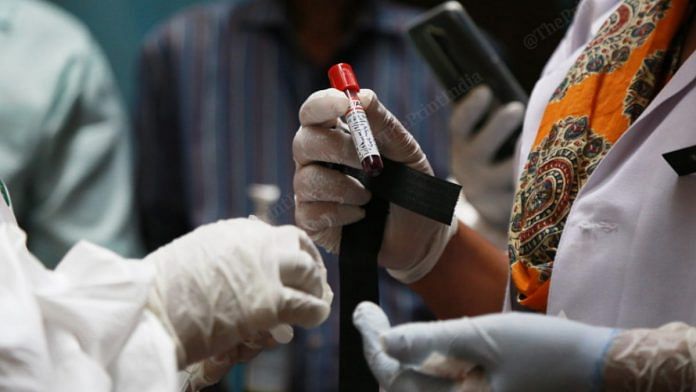New Delhi: Since 8 January this year, India has reported 1,50,64,691 cases of Covid-19. This means that 50 per cent of the country’s total Covid caseload was recorded in a little over four months. And yet, not a single national serological survey has been done to estimate the extent of infection in the community, beyond the reported cases.
The results of the last sero survey, which were announced in February this year, showed that India had missed about 27 crore of the roughly 28 crore infections it had by the beginning of the year. The survey was carried out between 17 December 2020 and 8 January 2021. None was planned after that.
According to top sources in the Government of India, talks have now been initiated for the Indian Council of Medical Research (ICMR) — the country’s apex medical body — to do a fresh sero survey to assess the extent of the infection in the community. They have, however, been non-committal on whether the survey will take place in the next month or so.
Officially, about 1.8 per cent Indians have so far been detected with the SARS-CoV-2 virus. However, the December sero survey put the extent of infection in the population at 21.4 per cent.
“There would be some amount of underreporting of infections as many people remain asymptomatic throughout the duration of their illness. See, in the last sero survey we found that to understand the real spread of the infection we had to multiply reported cases by a factor of 26. That would obviously have gone up now,” said a top government official, who is part of the government’s Covid management efforts.
“My own assessment would be that the sero prevalence currently would be at 40-50 per cent of the population, but without a sero survey it is difficult to assess. We have started talking to ICMR about a sero survey that will tell us the extent of infections we may have missed.”
If the same lens as the last sero survey is used, India’s actual infection numbers would be over 60 crore of the present data. However, the official cited the difference in the extent of underreporting revealed by the first and second sero surveys — in April 2020 and August 2020 — to warn against trusting that assessment too much.
“In the first survey the undercounting was by a factor of 90. That is because in the initial days we were testing less. But then it came down to about 26. That’s the level it remained in so it is possible that we have maintained that ratio,” the official, who wished to remain unnamed, told ThePrint.
“Only a sero survey will give the correct picture and that is what we are going for now,” he said, but did not confirm if the survey will be done by June.
Also read: Why Karnataka’s Hassan, home of Gowdas, is among India’s top Covid-hit rural districts
Importance of sero surveys
A serological survey estimates the percentage of the population that has been exposed to a virus by looking at the antibodies present in blood plasma to assess prior exposure.
It is crucial for estimating the extent of infection in a population as it is nearly impossible for any health system to detect all Covid cases especially since about 80 per cent of those infected remain asymptomatic.
The difference between an infection and a case is that the latter is medically diagnosed. The infection-to-case ratio is a measure of what proportion of infections were diagnosed while the infection fatality ratio looks at deaths as a proportion of infections and not cases.
“Well-designed serological surveys give a periodic profile of the levels of virus exposure in different population groups across the diverse geography of India. They should not, however, be taken as proof of immunity as experience with past mistakes of assumed herd immunity have clearly shown. The antibodies detected in a survey are not characterised for their ability to neutralise the wild virus or its variants,” said Dr K.S. Reddy, president of Public Health Foundation of India and member of the Covid-19 task force.
“The surveys will, however, show how effective our containment measures have been, if we analyse the time trends in percentage of antibody positivity in non-vaccinated persons. Those who have been vaccinated have to be analysed separately,” Dr Reddy added.
Some states have done sero surveys in the interim but the spread of the surveys and their frequency have been erratic. With India’s vaccination campaign struggling, a correct estimation of the extent of infection in the community could give a better idea about the percentages of the population that remain vulnerable.
In an article published Wednesday, Professor Manindra Agrawal from IIT Kanpur, who is one of the architects of the India-specific Covid-19 supermodel commissioned by the government, wrote: “…it is important that regular sero-surveys are conducted at national, state and even major district levels. ..As these sero-surveys need to be done regularly and provide results quickly, many countries have opted to use blood samples collected from a region over a short period of time, and perform sero-tests on them to estimate immunity levels. Such surveys are adequate to provide a decent estimate. The same methodology must be adopted in India too to track the susceptibility of population in different regions.”
(Edited by Rachel John)
Also read: How Mumbai did a better job than Delhi in fighting the second wave of Covid



